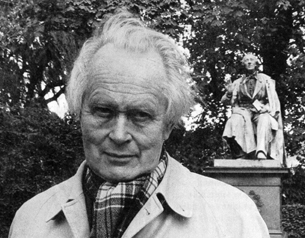Famous Piet Hein Quotes
“The universe may
be as great as they say.
But it wouldn't be missed
if it didn't exist.”
Nothing Is Indespensable : Grook to warn the universe against megalomania
Grooks
Hint And Suggestion : Admonitory grook addressed to youth
Grooks
Consolation Grook, his first grook, published in Politiken (April 1940) as translated in Grooks (1966)
Grooks
Piet Hein Quotes about life
Piet Hein Quotes about art
“Art is the creative process and it goes through all fields.”
As quoted in Man Creates Art Creates Man (1973) by Duane Preble, p. 14
Variant translation: Art is solving problems that cannot be formulated before they have been solved. The shaping of the question is part of the answer.
As quoted in Architecture: form, space, and order (2007) by Francis D.K. Ching, p. ix
Context: After all, what is art? Art is the creative process and it goes through all fields. Einstein’s theory of relativity — now that is a work of art! Einstein was more of an artist in physics than on his violin.
Art is this: art is the solution of a problem which cannot be expressed explicitly until it is solved.
As quoted in Man Creates Art Creates Man (1973) by Duane Preble, p. 14
Variant translation: Art is solving problems that cannot be formulated before they have been solved. The shaping of the question is part of the answer.
As quoted in Architecture: form, space, and order (2007) by Francis D.K. Ching, p. ix
Context: After all, what is art? Art is the creative process and it goes through all fields. Einstein’s theory of relativity — now that is a work of art! Einstein was more of an artist in physics than on his violin.
Art is this: art is the solution of a problem which cannot be expressed explicitly until it is solved.
Piet Hein Quotes
As quoted in Scandinavian Review (2003), by the American-Scandinavian Foundation, p. 18
Context: Man is the animal that draws lines which he himself then stumbles over. In the whole pattern of civilization there have been two tendencies, one toward straight lines and rectangular patterns and one toward circular lines. There are reasons, mechanical and psychological, for both tendencies. Things made with straight lines fit well together and save space. And we can move easily — physically or mentally — around things made with round lines. But we are in a straitjacket, having to accept one or the other, when often some intermediate form would be better.
“Put up in a place
where it's easy to see
the cryptic admonishment”
T.T.T. (Acronym in Danish: Ting Tager Tid)
Grooks
Context: p>Put up in a place
where it's easy to see
the cryptic admonishmentT. T. T.When you feel how depressingly
slowly you climb,
it's well to remember that
Things Take Time.</p
“Those
that are looking
for nothing — will find it.”
Look And Thou Shalt Find
Grooks
Context: Foes
of what's cooking
see no worth behind it.
Those
that are looking
for nothing — will find it.
“Man is the animal that draws lines which he himself then stumbles over.”
As quoted in Scandinavian Review (2003), by the American-Scandinavian Foundation, p. 18
Context: Man is the animal that draws lines which he himself then stumbles over. In the whole pattern of civilization there have been two tendencies, one toward straight lines and rectangular patterns and one toward circular lines. There are reasons, mechanical and psychological, for both tendencies. Things made with straight lines fit well together and save space. And we can move easily — physically or mentally — around things made with round lines. But we are in a straitjacket, having to accept one or the other, when often some intermediate form would be better.
“Somebody said
that Reason was dead.
Reason said: No,
I think not so.”
Dead Reasonable
Grooks
“Err
and err
and err again
but less
and less
and less.”
The Road to Wisdom?
Grooks
Context: The road to wisdom? — Well, it's plain
and simple to express:
Err
and err
and err again
but less
and less
and less.
Lest Fools Should Fail
Grooks
“if you posses
more than just eight things
then y o u
are possessed by t h e m”
The Tyranny Of Things
Grooks
A Psychological Tip
Grooks
“Idiots are really
one hundred per cent
when they are also
intelligent.”
The Final Touch : Portrait of nobody in particular
Grooks
“To be and not to be, that is the answer.”
This witticism derived from William Shakespeare's line "To be or not to be; that is the question" in Hamlet, has sometimes been attributed to Hein, but also to many others. The earliest occurrence so far located in research for Wikiquote was published in A Calendar of Doubts and Faiths (1930) by William Marias Malisoff.
Misattributed
